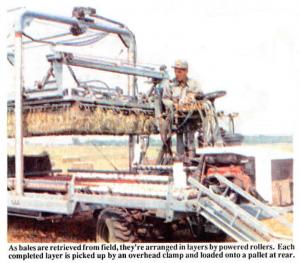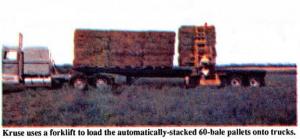Self Propelled Hay Bale Stacker, Retriever
When Marvin Kruse decided to add alfalfa as a cash crop on his Tecumseh, Wash., farm, he wanted to do it without adding any more labor to his operation. The only way he could handle 150 acres of hay with just two people was to build a machine to automatically retrieve and stack the bales.
"I designed the machine and started gathering parts a few years before building it," says Kruse, who built his "Hay Pal" bale retriever and stacker in one winter in his shop. The self-propelled machine, powered by a 262 propane-powered Chevy engine, scoops bales up one at a time from the field and loads them onto wood pallets for easy handling with a forklift for storage or to load onto flatbed trucks.
"Hay Pal" picks bales off the field with a bale chain and carries the bale onto a roller-equipped bed that moves bales into varying patterns for stacking on a pallet. The stacking pattern is changed each layer to tie the bales together, forming a neat 6-layer cube of 60 bales.
"When we first built it the operator had to manually control the hydraulic orbit motors which move the bales into different stacking patterns_ After using it for a year, we modified it with microswitches and solenoid controlled hydraulic valves so that it would create different tie patterns automatically. Now the operator can create any tie pattern by the simple flip of a switch," explains Kruse.
The bale machine's Chevy engine controls a hydrostat motor out of a Massey combine. The hydraulic motor is hooked up to a 3-speed transmission and an Army truck transfer case which powers the front-wheel drive axle.
The machine handles all bales as they're dropped by the baler. As each layer of bales is completed, an overhead clamp picks up the layer and stacks it onto a pallet carried on the rear. When the stack reaches 6 layers, the pallet is dropped off. Loaded pallets are the correct width and height for truck transportation and can be loaded with a forklift directly onto a truckbed. The pallets also provide good air circulation for stacking in hay sheds. Pallets of bales can be stacked on top of each other.
"Even though we raise 150 acres, our hay is never touched by human hands and all work from start to finish is done by two of us. There's more demand for small bales than large bales because waste is reduced and there's more cortrol over feeding. Our equipment makes small square bales as efficient to handle as large round or square bales," says Kruse, who has patented his bale machine and is looking for a manufacturer.
For more information, contact: FARM SHOW Followup, Marvin F. Kruse, Rt. 3, Box 178, Tecumseh, Neb. 68450 (ph 402 335-2300).

Click here to download page story appeared in.
Click here to read entire issue
Self propelled hay bale stacker, retriever HAY & FORAGE HARVESTING Bale Handling (5) 13-4-36 When Marvin Kruse decided to add alfalfa as a cash crop on his Tecumseh, Wash., farm, he wanted to do it without adding any more labor to his operation. The only way he could handle 150 acres of hay with just two people was to build a machine to automatically retrieve and stack the bales.
"I designed the machine and started gathering parts a few years before building it," says Kruse, who built his "Hay Pal" bale retriever and stacker in one winter in his shop. The self-propelled machine, powered by a 262 propane-powered Chevy engine, scoops bales up one at a time from the field and loads them onto wood pallets for easy handling with a forklift for storage or to load onto flatbed trucks.
"Hay Pal" picks bales off the field with a bale chain and carries the bale onto a roller-equipped bed that moves bales into varying patterns for stacking on a pallet. The stacking pattern is changed each layer to tie the bales together, forming a neat 6-layer cube of 60 bales.
"When we first built it the operator had to manually control the hydraulic orbit motors which move the bales into different stacking patterns_ After using it for a year, we modified it with microswitches and solenoid controlled hydraulic valves so that it would create different tie patterns automatically. Now the operator can create any tie pattern by the simple flip of a switch," explains Kruse.
The bale machine's Chevy engine controls a hydrostat motor out of a Massey combine. The hydraulic motor is hooked up to a 3-speed transmission and an Army truck transfer case which powers the front-wheel drive axle.
The machine handles all bales as they're dropped by the baler. As each layer of bales is completed, an overhead clamp picks up the layer and stacks it onto a pallet carried on the rear. When the stack reaches 6 layers, the pallet is dropped off. Loaded pallets are the correct width and height for truck transportation and can be loaded with a forklift directly onto a truckbed. The pallets also provide good air circulation for stacking in hay sheds. Pallets of bales can be stacked on top of each other.
"Even though we raise 150 acres, our hay is never touched by human hands and all work from start to finish is done by two of us. There's more demand for small bales than large bales because waste is reduced and there's more cortrol over feeding. Our equipment makes small square bales as efficient to handle as large round or square bales," says Kruse, who has patented his bale machine and is looking for a manufacturer.
For more information, contact: FARM SHOW Followup, Marvin F. Kruse, Rt. 3, Box 178, Tecumseh, Neb. 68450 (ph 402 335-2300).
To read the rest of this story, download this issue below or click
here to register with your account number.








